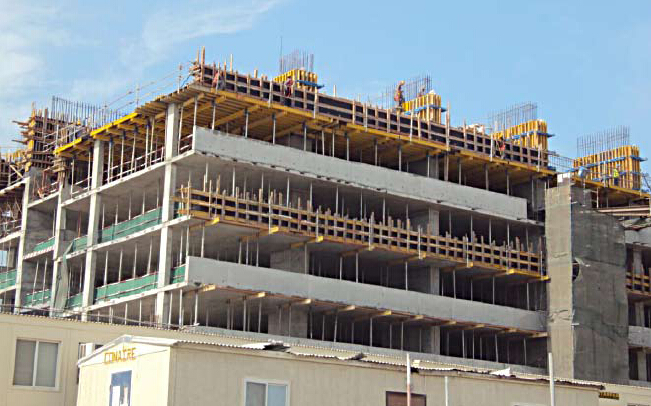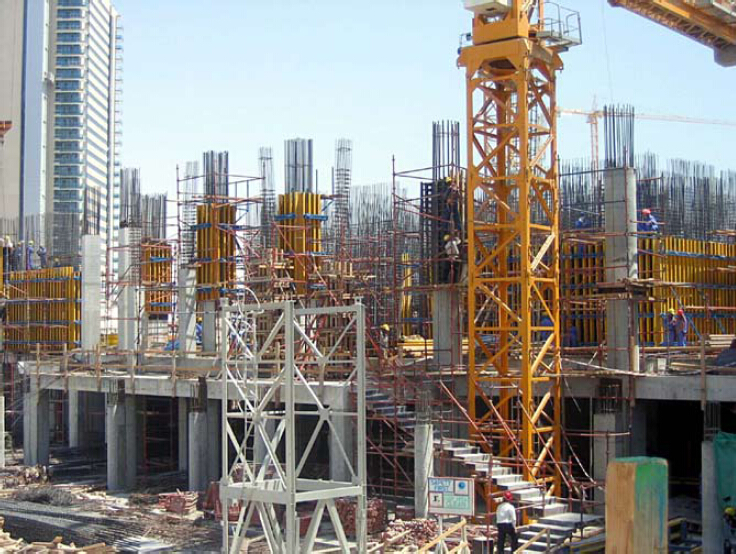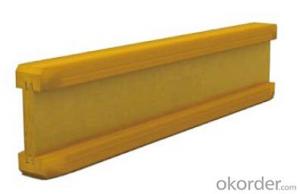Timber-beam for formwork and scaffolding system
- Loading Port:
- Tianjin
- Payment Terms:
- TT OR LC
- Min Order Qty:
- 50 m²
- Supply Capability:
- 1000 m²/month
OKorder Service Pledge
Quality Product, Order Online Tracking, Timely Delivery
OKorder Financial Service
Credit Rating, Credit Services, Credit Purchasing
You Might Also Like
Characteristics:
◆ Standardized production lines.
Supply capability: 3000m/day, Lmax = 6600mm.
◆ Finger jointing of the flange and web, the strength of timber beam is highly improved.
Max. shearing force failure load:40KN
◆ Well treated to prevent from water penetration or erosion, so the service life maximally extended.
Normally, CNBM timber beam H20 can be used for 4 to 5 years, the exact using time would depend on maintenance & storage.
◆ Robust caps at the end of the girders protect against damages.


- Q:How does steel formwork impact the overall cost of a construction project?
- Steel formwork can have a significant impact on the overall cost of a construction project. While steel formwork may have a higher initial cost compared to traditional timber formwork, it offers several advantages that can result in cost savings in the long run. Firstly, steel formwork is more durable and has a longer lifespan than timber formwork. It can withstand multiple uses without significant wear and tear, reducing the need for frequent replacements. This longevity of steel formwork eliminates the costs associated with purchasing new formwork materials for each construction project, resulting in long-term savings. Moreover, steel formwork provides superior strength and stability, allowing for larger and more complex construction designs. This enhanced structural integrity can reduce the need for additional support systems, such as props or scaffolding, which can add to the overall costs of a project. Additionally, steel formwork can be easily customized to fit different shapes and sizes, minimizing wastage and optimizing material usage. Furthermore, steel formwork offers faster assembly and dismantling times compared to timber formwork. The modular nature of steel formwork allows for easy installation and removal, reducing labor costs and increasing productivity. The shorter construction cycle facilitated by steel formwork can lead to significant time savings, enabling early project completion and reducing financing costs. Another cost-saving aspect of steel formwork is its reusability. Steel formwork can be dismantled, cleaned, and reused in subsequent projects, minimizing the need for new formwork materials. This not only reduces the material procurement costs but also decreases waste generation and environmental impact. However, it is important to note that the cost impact of steel formwork will vary depending on the specific project requirements and regional factors such as material availability and labor costs. Therefore, a detailed cost analysis considering all these factors is crucial in determining the overall cost-effectiveness of steel formwork for a construction project.
- Q:How does steel formwork affect the overall waste management of the construction process?
- Steel formwork can have a positive impact on the overall waste management of the construction process. Unlike traditional timber formwork, steel formwork can be reused multiple times, reducing the amount of waste generated during construction. This not only minimizes the need for raw materials but also decreases the amount of waste that needs to be disposed of. Additionally, steel formwork is more durable and resistant to damage, further extending its lifespan and reducing waste. Overall, the use of steel formwork in construction can contribute to a more sustainable and efficient waste management system.
- Q:What are the factors to consider when selecting steel formwork?
- To choose the right steel formwork, one must take into account various factors. Firstly, the strength and durability of the formwork are crucial. It should be able to bear the weight of the concrete and withstand the forces applied during pouring and curing. Additionally, it should maintain its structural integrity after multiple uses. Secondly, flexibility and adaptability are important considerations. The formwork should be easily adjustable and capable of accommodating different shapes and sizes of concrete elements. This is especially vital for complex or irregular structures. Next, the ease of assembly and dismantling plays a significant role. The formwork system should be quick and straightforward to put together and take apart, as this affects the overall construction timeline. The use of standardized components and a simple connection system can expedite this process. Furthermore, the surface finish of the concrete is a key factor, particularly for architectural projects. The steel formwork should provide a smooth and flawless surface without any visible marks or imperfections, ensuring a high-quality end result. Considering cost-effectiveness is also essential. The total cost of the formwork system, including the initial investment, maintenance, and reusability, should be taken into account. Although steel formwork may have a higher upfront cost, its durability and reusability make it a cost-effective choice in the long run. Safety is of paramount importance. The design and manufacture of the steel formwork should incorporate safety features such as non-slip surfaces, secure connections, and sufficient bracing to prevent accidents or collapses. Additionally, the environmental impact of the formwork material should be considered. Steel formwork is often considered more environmentally friendly than traditional timber formwork due to its ability to be reused and recycled. By considering these factors, construction professionals can make an informed decision when selecting steel formwork that meets their project requirements and delivers optimal results.
- Q:Can steel formwork be used for curved or complex structures?
- Yes, steel formwork can be used for curved or complex structures. Steel formwork is highly versatile and can be easily shaped and adjusted to create various curved or complex shapes. Its strength and durability make it suitable for withstanding the pressure and forces exerted during the construction process of such structures.
- Q:What are the main components of a steel formwork system?
- The main components of a steel formwork system typically include panels, connectors, clamps, pins, and wedges.
- Q:What are the different components of steel formwork?
- The different components of steel formwork include panels, stiffeners, walers, soldiers, ties, and connectors.
- Q:How does steel formwork affect the overall construction site waste recycling?
- The overall waste recycling at a construction site can be greatly influenced by steel formwork. In contrast to traditional timber formwork, steel formwork is more long-lasting and can be reused multiple times. This results in a decrease in waste production at the construction site since there is less necessity for the production and disposal of new formwork materials. Furthermore, cleaning and maintaining steel formwork is simpler, which extends its lifespan and reduces the need for replacement. This not only decreases waste but also saves costs associated with purchasing new formwork materials for each construction project. Moreover, steel formwork is highly recyclable. Once its life cycle is complete, it can be recycled and utilized to manufacture new steel products, diminishing the demand for fresh materials and reducing the environmental impact. Through the utilization of steel formwork, construction sites can greatly diminish their waste generation and contribute to a more sustainable construction industry. This not only benefits the environment but also promotes a more efficient and cost-effective approach to construction.
- Q:How does steel formwork affect the overall constructability of a structure?
- The overall constructability of a structure can be significantly impacted by steel formwork. One of the main benefits of using steel formwork is its durability and strength. Steel is renowned for its high load-bearing capacity, enabling it to withstand the pressure exerted by fresh concrete during pouring and curing. This durability guarantees that the formwork remains stable and intact, minimizing the risk of collapse or deformation during construction. Another advantage of steel formwork is its reusability. Unlike traditional formwork materials like timber, steel can be utilized multiple times without compromising its structural integrity. This not only saves costs associated with purchasing new formwork for every construction project but also reduces waste and promotes sustainability. Steel formwork also provides flexibility and versatility in terms of design and construction requirements. It can be easily fabricated into various shapes and sizes, enabling the construction of intricate structures with detailed architectural elements. Steel formwork can be customized to suit specific project needs, facilitating efficient and precise construction. Furthermore, steel formwork delivers a smooth and uniform finish to the concrete surface. This eliminates the need for additional finishing work, such as plastering or sanding, thereby reducing construction time and costs. The smooth finish also enhances the aesthetic appeal of the structure, making it suitable for architectural projects where visual appeal is crucial. Moreover, steel formwork is recognized for its excellent dimensional stability. It resists warping, shrinking, or expanding due to moisture or temperature changes, ensuring accurate and consistent dimensions throughout the construction process. This dimensional stability contributes to the overall quality and precision of the structure. In conclusion, steel formwork has a positive impact on the overall constructability of a structure by offering durability, reusability, flexibility, a smooth finish, and dimensional stability. These advantages not only enhance construction efficiency and speed but also guarantee the structural integrity and aesthetic appeal of the final product.
- Q:How does steel formwork contribute to the structural stability of the concrete elements?
- Steel formwork is utilized in the construction process to provide support and shape to concrete elements. It plays a critical role in maintaining the structural stability of these elements. To begin with, steel formwork offers a rigid and stable framework for the concrete, preventing any deformation or movement during the pouring and curing stages. This is vital as it allows the concrete to set and harden in the desired shape and position. Without proper support, the concrete may slump or sag, resulting in compromised structural integrity. Moreover, steel formwork is engineered to withstand the high pressure exerted by the wet concrete. The steel panels or frames are durable and strong enough to endure the weight of the concrete and any external forces that may be applied. This capability is particularly important in cases of tall or complex structures where the concrete may be subject to significant loads. Furthermore, steel formwork allows for precise shaping of the concrete elements. The steel panels or frames can be easily adjusted and aligned to the desired dimensions, ensuring that the final concrete structure adheres to the design specifications. This level of accuracy is crucial for the overall structural stability of the concrete elements as any inconsistencies or deviations can compromise the load-bearing capacity. Additionally, steel formwork enables efficient and effective construction processes. It can be easily assembled, disassembled, and reused, reducing construction time and costs. Furthermore, the smooth surface of the steel formwork provides a high-quality finish to the concrete elements, eliminating the need for additional treatments or formwork. In conclusion, steel formwork significantly contributes to the structural stability of concrete elements. Its rigid and stable support ensures that the concrete sets and hardens in the desired shape, while its strength and durability withstand the pressure and loads exerted by the concrete. The precise shaping capabilities of steel formwork guarantee the alignment and dimensions of the concrete structure, and its efficiency and effectiveness streamline the construction process.
- Q:How does steel formwork affect the overall productivity of the construction process?
- Steel formwork can significantly enhance the overall productivity of the construction process. Due to its durability and strength, steel formwork allows for faster assembly and disassembly, reducing the time required for each construction cycle. Its reusable nature also reduces the need for constant replacements, reducing both material and labor costs. Additionally, the precise and consistent dimensions of steel formwork ensure accurate and high-quality construction, minimizing errors and rework. Overall, steel formwork increases efficiency, reduces construction time, and enhances the productivity of the construction process.
1. Manufacturer Overview |
|
|---|---|
| Location | |
| Year Established | |
| Annual Output Value | |
| Main Markets | |
| Company Certifications | |
2. Manufacturer Certificates |
|
|---|---|
| a) Certification Name | |
| Range | |
| Reference | |
| Validity Period | |
3. Manufacturer Capability |
|
|---|---|
| a)Trade Capacity | |
| Nearest Port | |
| Export Percentage | |
| No.of Employees in Trade Department | |
| Language Spoken: | |
| b)Factory Information | |
| Factory Size: | |
| No. of Production Lines | |
| Contract Manufacturing | |
| Product Price Range | |
Send your message to us
Timber-beam for formwork and scaffolding system
- Loading Port:
- Tianjin
- Payment Terms:
- TT OR LC
- Min Order Qty:
- 50 m²
- Supply Capability:
- 1000 m²/month
OKorder Service Pledge
Quality Product, Order Online Tracking, Timely Delivery
OKorder Financial Service
Credit Rating, Credit Services, Credit Purchasing
Similar products
New products
Hot products
Hot Searches
Related keywords

























